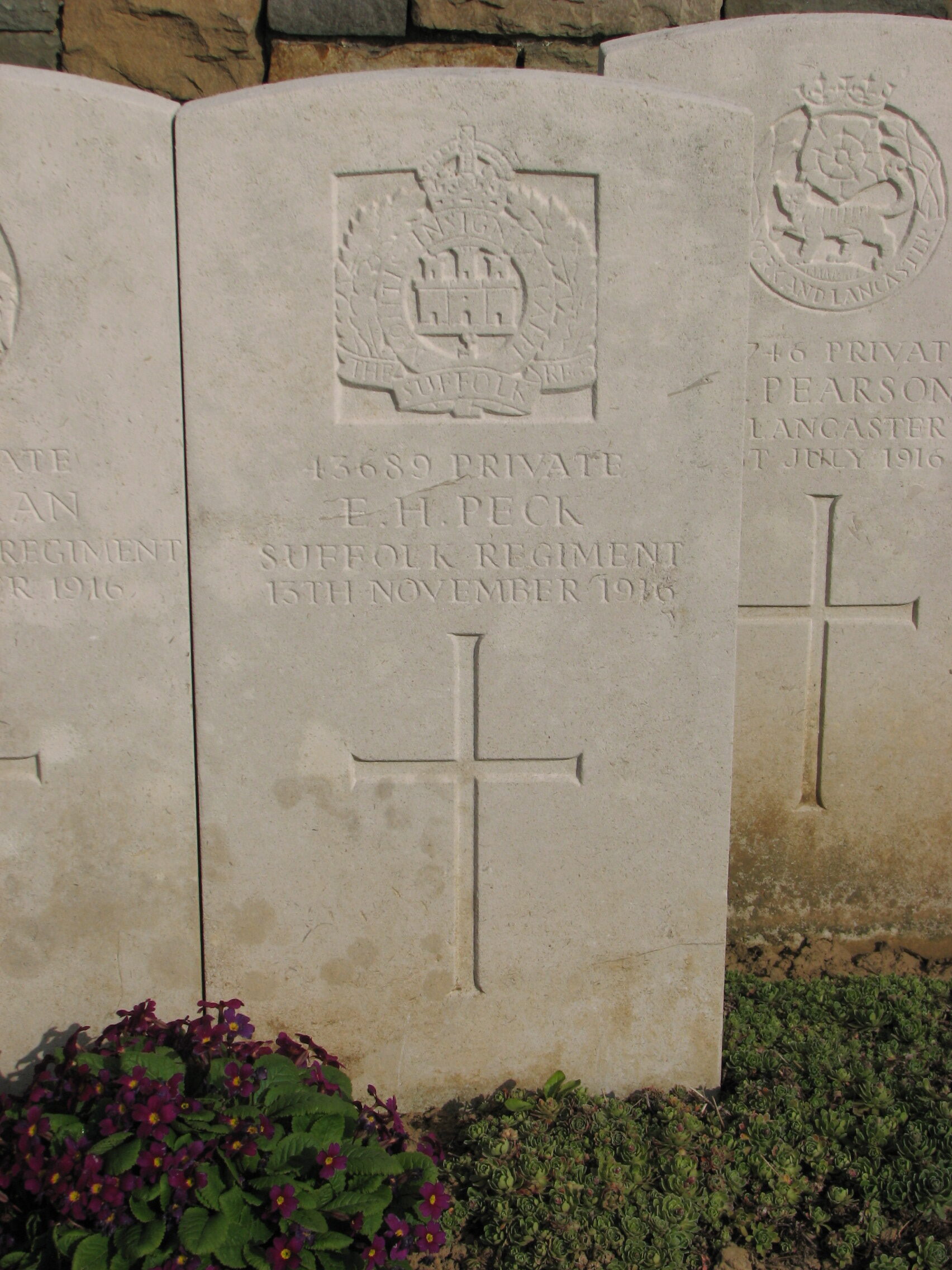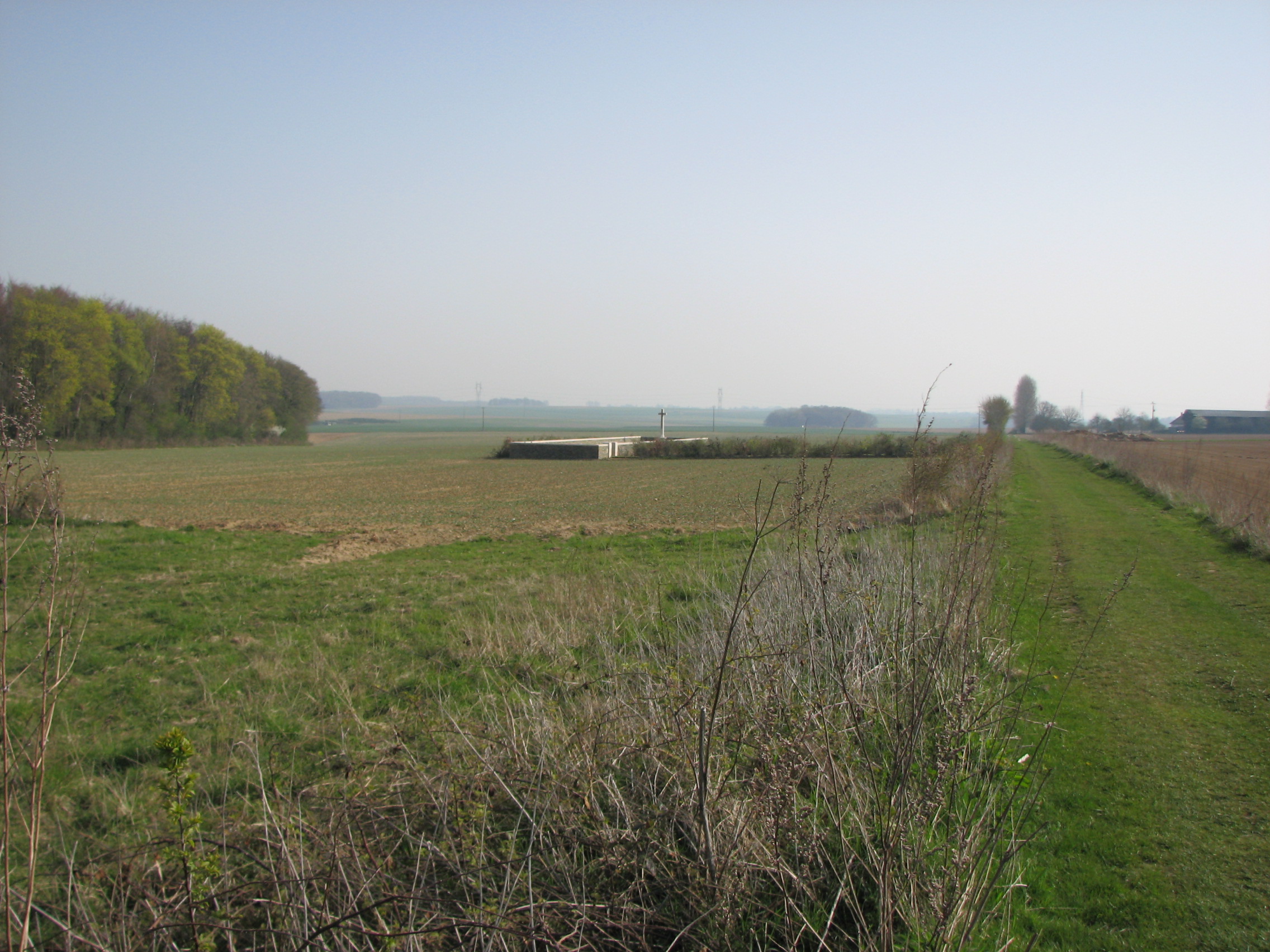Eric Peck (1896 - 1916)
Brother of Leonard Peck. Eric served in France with 2nd Battalion of the Suffolk Regiment. He was killed in an attack against the fortified village of Serre, during the closing weeks of the Battle of the Somme.
- 52
- Died in the Great War
- 51.975644, 1.009775
Details
| Name: | Eric Harold Peck |
| Service: | British Army |
| Unit: | 2nd Battalion, Suffolk Regiment |
| Regimental Number: | 43689 |
| Rank: | Private |
| Date of Death: | 13th November 1916 |
| Age: | 20 |
| Buried: | Grave 23, Luke Copse Cemetery, Puisieux, near Albert, France |
Family Background and Early Life
Eric Harold Peck was born in East Bergholt on 3rd March 1896, the fourth son of Walter and Jane Peck.
Walter was a Cattle Stockman, who was originally from Westhall, near Halesworth. He had married Jane Cheverton from Great Wenham, in 1890, and together they would have thirteen children, though three died in childhood.
By the April of 1901, the Peck family were living at Ackworth Lodge, though at some point in the next four years they moved to Woodgates Cottages.
Eric, along with his cousin Sydney, started at the village school at Burnt Oak on 17th June 1901, and he remained a pupil there until 2nd February 1910. 1 Sydney Peck would later serve in the Machine Gun Corps, during the Great War.
Sydney’s older brother Herbert, served with the Essex Regiment on the Western Front. Herbert was killed on 22 March 1918 March 1918, during the German Spring Offensive. Herbert is officially commemorated by a Special Memorial in the Vaulx Hill Cemetery, where he is almost certainly buried. After he left School, Eric found employment as a Grocer’s Porter.
The Peck family worshipped at the Congregational Church, and Eric along with five of his brothers are remembered on the memorial plaques there. 2 Of Walter and Jane’s 5 sons who served in the British Army during the Great War, only Cecil’s name did not appear in the Casualty Lists:
Leonard, the eldest son, served in the Royal Field Artillery on the Western Front. He died in 1919 from the effects of a gas attack the previous year and is buried in East Bergholt Cemetery.
Arthur – who served in the Machine Gun Corps – was also gassed. He survived the War.
Bertie survived the War, but had been wounded. He served with the Suffolk Regiment and later, the Royal Welsh Fusiliers.
Edmund survived the War. He served with the Manchester Regiment on the Western Front and was captured by the Germans in March 1918.
Cecil survived the War. He served with the Royal Fusiliers on the Western Front in 1918.
Joins the Army
Unfortunately, Eric’s Service Record no longer survives, so we do not have documentary proof of when he joined the Army, nor exactly when he was sent overseas.
There is some evidence to suggest that Eric may have volunteered for service in the British Army under the Group Scheme in early 1916, rather than being conscripted. The Scheme was effectively a last ditch attempt by the government to increase recruitment by voluntary means, before they had to resort to conscription.
If Eric did volunteer under the Derby Scheme, then it seems that – as permitted under the terms of the Scheme – he then chose to initially become a part of the Army Reserve, which meant that he could go back to his civilian occupation until he was required.
Eric was called up in early April of 1916 and joined to the 8th Battalion of the Northamptonshire Regiment for his basic training in England. A period of further instruction followed at an Infantry Base Depot after he disembarked in France, which most likely occurred sometime during July or August.
France
From 1916 onwards, it became common for an infantry soldier to be transferred to another regiment upon arrival in France. Eric was one of a number of men from the Northamptonshires who were posted to the 2nd Battalion of the Suffolk Regiment.
At that time, the Battle of the Somme had been raging for over a month, and the 2nd Suffolks had just been involved in two costly attacks, near the village of Guillemont. They suffered nearly 300 casualties in just a few days, including Joseph Abbott from East End, who was killed. 3 Joseph Abbott was killed in action on 16 August 1916, aged 19. He has no known grave and is commemorated on the Thiepval Memorial to the Missing of the Somme.
Following their losses in the mid-August attacks, the 2nd Suffolks were pulled out of the line and marched north to a quieter sector of the front at Mazingarbe, near Lens. They spent most of September in that area. Even though this was – at that time – a quieter sector of the Front, the Battalion still suffered casualties on most days that they were in the Line.
The Battalion came out of the Line on 22nd September and moved to the rear. Over the next 6 weeks, during which they moved back to the Somme, they were engaged either in training and also on working parties. These duties were interrupted for a short period in October, when they went back into the line.
The Battalion were one of the units had been earmarked to take part in a fresh series of attacks which formed part of the wider ongoing offensive that is now called the Battle of the Somme. By this stage, the Battle had been going on for over four months.
Serre
On 12th November 1916, the 2nd Suffolks moved into their waterlogged assembly trenches, ready for an attack against the fortified village of Serre early the next morning. In addition to Eric, four other local men – all from Brantham – were in the Battalion’s ranks.
Over four months earlier – on the first day of the Battle – some of the “Pals Battalions” had attacked over exactly the same ground in an attempt to capture Serre. They had had been bloodily repulsed. The British High Command had now decided that a second attempt would be made.
The 2nd Suffolks attack on the morning of 13th November was a costly failure: Against heavy rifle and machine-gun fire – in what was described as “a sea of mud in which movement was barely possible” – some of the Battalion managed to fight their way to the German front line. 4 Quotation taken from “The History of the Suffolk Regiment 1914-1927”, by Lieutenant-Colonel C.C.R. Murphy, Hutchinson & Co., 1928. It was in vain, and they were finally forced to withdraw to their assembly trenches after suffering heavy losses.
The Battalion’s Roll Call revealed that they had suffered 261 casualties, including 17 killed. 94 wounded and 161 missing. Time would show that 66 of the missing men had in fact been killed.
Missing
The Army notified Eric’s parents that he was Missing, meaning that he could either be dead, held as a prisoner by the Germans, or somehow temporarily unaccounted for due to another reason. In fact, Eric had been killed, though this would not be known for some time.
Eric’s body – like the bodies of most of his comrades who had been killed in the attack – lay where he had fallen out in No Man’s Land, between the British and German front lines. It was only in the Spring of 1917, after the Germans had retreated to a new defensive line, that the British were able to occupy the area and finally bury their dead.
In the early summer of 1917 – following the German retreat – Eric’s body was found and identified. Shortly afterwards – in the July – his parents were finally given some sort of closure when the Army were able to confirm to them that Eric had been killed in the attack of 13th November 1916.
The casualties suffered by the 2nd Suffolks during the attack on Serre also included the four Brantham men: Frederick Fieldgate (from New Village) and William Meakins (who lived opposite St. Michael’s Church), were both killed. Isaac Fisk and Cyril Pyett (who both lived near The Bull) were wounded and Cyril had also been captured by the Germans. 5 Isaac Fisk recovered from his wounds and returned to duty. He was killed in action on 9th April 1917, during the Battle of Arras. Isaac has no known grave and is commemorated on the Arras Memorial.
Cyril Pyett died from Influenza in a German Prisoner of War Camp, on 6th November 1918 – less than one week before the Armistice. Cyril now rests in the Berlin South-Western Cemetery, Germany.
Postscript
Eric – along with 71 others, including William Meakins – was buried in a trench dug in the old No Man’s Land, close to where they fell. Today that same grave – now called Luke Copse British Cemetery – is lovingly maintained by the Commonwealth War Graves Commission. 6 Frederick Fieldgate is buried in Queens Cemetery, which is located a few hundred yards away from Luke Copse Cemetery.
Eric’s parents remained in East Bergholt for the rest of their lives. Walter died in 1940 and Jane died in 1950. Both are buried in the village Cemetery.
Eric is remembered on the two stones which mark the grave of his brother Leonard in East Bergholt Cemetery. One is a Commonwealth War Graves Commission headstone which replaced an earlier headstone erected by Leonard’s family. The other is the original headstone, which is now located at the foot of Leonard’s grave.
Copyright © Mark Ashmore, 2024
- 52
- Died in the Great War
- 51.975644, 1.009775




